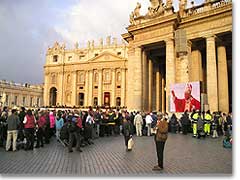 |
|
El Santo Padre nos salude... The Holy Father greeting us... Der Heilige Vater begrüßt uns noch einmal... |
|
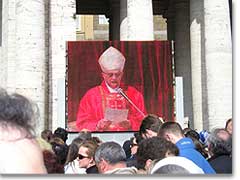 |
|
Cardenal Ratzinger, predica Cardinal Ratzinger during the sermon Kardinal Ratzinger bei der Predigt |
|
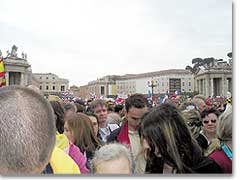 |
|
Una multitud en San Pedro A multi-colored crowd at St. Peter’s Gottes Volk auf dem Petersplatz |
|
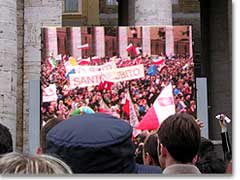 |
|
Santo subito, santo ya Santo súbito, holy now! Santo subito, heilig jetzt! |
|
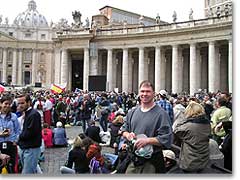 |
|
Muchos durmieron en la Plaza Many slept the night before on the Square or in the streets Viele haben im Freien übernachtet, um früh da zu sein |
|
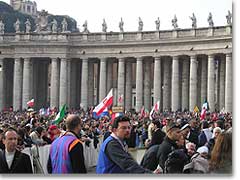 |
|
Tristeza y esperanza Sadness and hope Trauer und Hoffnung Fotos: Donnelly © 2005 |
|
|
ROME, Simon Donnelly. On Thursday night, an American friend and her son slept on the streets of Rome to get a good chance of being near Saint Peter’s Square on the morning of the Holy Father’s funeral. So did thousands of Polish pilgrims, and also Italians and other visitors. From my college, our Polish postgraduate priest from Koszalin diocese received four priest friends and students who had driven 2000 km in two days, stopping the previous night in Leipzig. They were very tired but happy to be in Rome. They set out from our college at 3.30am on Friday morning, to catch a night bus to Piazza Venezia, hoping to be on the Conciliazione, at least within sight of Saint Peter’s, for the funeral Mass. Others similarly left in the small hours of the morning.
I left only much later, only after 6am, not expecting to be anywhere near St Peter’s for the funeral. I felt I was far too late already... but the Lord in his goodness, aided certainly by the intercession of our Mother and Queen, had other plans. I met a priest friend, by surprise, who had a magical document called a notificazione, which would get him through all levels of security, as he would be distributing Holy Communion at the requiem Mass. We caught an early bus towards the Olympic Stadium, where thousands of people were emerging from their tents and tour buses. The Rome municipality had laid on free buses to get us as close to Saint Peter’s as possible.
Approaching the House of the Lord
Walking towards Saint Peter’s always gives you a real sense of approaching the House of the Lord, as you join other pilgrims and visitors streaming to the largest church in the Christian world. But this morning, there was a sea of humanity, tens of thousands of us. Some Polish pilgrims wore scarves saying Solidarnosc (‘Solidarity’), the name of the Polish worker’s movement that our pope had supported, which led ultimately to the fall of communism in Poland.
We had to step over sleeping bodies on the pavement, and other bodies just waking up. These pilgrims had braved a chilly, uncomfortable night just to be here. The piazzas near St Peter’s were already nearly full. I really never expected to get anywhere near the main piazza. But in Italy if you walk confidently, and have some ecclesial function, you sometimes manage to pass through security. And so we did, time after time. I followed my friend, and we both followed some Bishops who we had caught sight of. Finally, to my astonishment, we were able to reach the main piazza itself. This was the first miracle of my day. I felt truly unworthy to be there. And yet, Our Lady had gently nudged me along, all the way to the Square where I had been when the Pope had died six days previously... the same piazza where we had celebrated his 25th anniversary just 18 months ago.
I gave thanks, too, for something particularly precious: being able to receive the Mass booklet that accompanies all major events at Saint Peter’s; Friday’s was simply called Messa Esequiale del Romano Pontefice (‘The Mass of the Funeral Rites of the Roman Pontiff’).
Welcome to World Youth Day 2005
As the crowds poured in, I saw many different signs that the faithful had brought with them. One of the most striking ones was also seen by many people on TV. It said, simply, Santo subito (literally, ‘Saint immediately’), that is, ‘Proclaim him a saint now!’. When the cameras showed this sign to us on the maxiscreens, we applauded enthusiastically. There is a strong popular demand that John Paul, our deceased pope, be proposed as a candidate for sainthood. Many people are convinced of his immensely holy life. He seems to us to be a man whose life is highly worthy of the status of saint. For anyone who may not know what John Paul accomplished, you have only to read any of the dozens of newspapers or magazines in Rome this week with special features on the life of this pope. He pontificate has been so long, that many of us have forgotten—or never known—the range of things he did for God’s people, on a larger international scale, but also on a quieter very personal level.
Another sign welcomed the Pope to World Youth Day 2005 in Cologne. We feel certain that John Paul will be there in spirit, even if not in person.
Brought together from the ends of the earth
On the piazza, a beautiful image of the Holy Father in a red vestment—blessing us—greeted us on the video screens. A soft spring day in Rome was dawning around me, very quiet, very gentle weather. Not a drop of rain. A light wind. Slowly, over the next three hours the piazza filled up, until it was full. Flags from the whole world, with the biggest number from Poland. I was surrounded by religious sisters, young people, old people, priests. An Irish Augustinian sister passed out some old holy cards with John Paul on them: ‘Pray for our Holy Father, the pope’. Even in death, we will pray for him.
I met a young Dutch Catholic businessman, who with a friend had flown here from Amsterdam. ‘We didn’t tell people where we going at work. They would think we were crazy’. I thought to myself of what this pope has done: he has brought us here from the ends of the earth. What a beautiful thing is this faith of ours, and what an extraordinarily faithful life he lived.
Around two hundred heads of state and dignitaries were seated next to the outdoor altar. We were content that they were there, but not particularly interested in them. For many of them (including the three American presidents), it must have been quite a wonder to be in front of a crowd of a million people, where no one has come here to see them.
A simple coffin made of cypress wood
At 10am, bishops and Cardinals poured into the sanctuary at the top of the steps in front of the basilica. Cardinal Ratzinger—with his quiet, shy, yet firm voice that we have heard ever since John Paul became Pope—welcomed us: Requiem aeternam dona ei, Domine: et lux perpetua luceat ei (‘Eternal rest grant unto him, oh Lord: and may perpetual light shine on him’)...
The body of our Pope had been laid in front of the altar, in a simple coffin made of cypress wood. The video screens showed us how many people were at the event, and they also showed us his coffin with the book of the Gospels on top of it. We wept to see him again, and we clapped loudly every time the camera showed us his coffin.
The first reading from Acts in South American Spanish: God makes no preferences among persons. The psalm to comfort us was ‘The Lord is my shepherd’. The second reading in English, from Philippians: ‘Continue to stand firm in the Lord’. The Gospel from John: Jesus says three times to Simon, son of John: ‘Do you love me?’ And then: ‘Indeed I say to you: when you were young, you went where you wished. When you are old, you will stretch out your hands, and someone else will take you where you do not wish to go’. Even though the Pope was certainly surrounded by people who loved him, and looked after him in his old age, the parallalels between the Gospel reading and the pope’s life were clear for all to see. He truly suffered in his last days: his death certificate says he died of septic shock, and irreversible cardiocirculatory collapse. But in the preceding years he had also suffered from Parkinson’s disease, progressive episodes of acute, insufficient breathing and the consequent tracheotomy this year, hypertrophe of the prostate complicated by urosepsis, and hypertensive heart disease. The man really suffered.
Follow me
Cardinal Ratzinger preached a brief, tender sermon, including a short biography of Karol Wojtyla. The theme was Our Lord speaking to the disciples: ‘Follow me’. And as the Cardinal said, Karol Wojtyla’s whole life was a response to that call: he followed the Lord to the ends of the earth. ‘Simon, son of John, do you love me? Feed my sheep’. And our Holy Father, John Paul, listened to the Lord’s call: he left his academic life in 1958, to become auxiliary bishop. Then he left his country to become pope 20 years later. And then, in his old age, the Pope suffered in silence, a silence which was very eloquent. And he had always found a divine mother in Mary, after his own mother had died. The words which touched us the most were what Cardinal Ratzinger said at the end: ‘Our beloved Pope is standing today at the window of the father’s house, ... he sees us and blessed us. Yes, bless us Holy Father.’
Thus, Cardinal Ratzinger addressed his friend, our departed Holy Father, directly. He also entrusted him to the Mother of God, who had guided him each day, and who will now guide him ‘to the eternal glory of her Son, our Lord Jesus Christ’. Cardinal Ratzinger’s brief testimony was full of the tenderness that only two close friends can share. I had seen that same tenderness at the celebration of the Holy Father’s 25th anniversary celebration outside Saint Peter’s in October 2003.
During the entire funeral Mass, Cardinal Ratzinger’s voice—and the other voices—came to me in stereo: from the altar in front of us, and slightly sooner than that the same voices broadcast on a Polish radio station, with a voiceover in Polish. The pilgrims from the Pope’s home country wanted to make sure that they missed nothing!
People applauded, and waved goodbye, and we all wept…
The funeral prayers of the faithful represented the wide world that John Paul had gone out to visit and to encourage: at this Mass they were in French, Swahili, Philippino, Polish, German, Portuguese. The communion hymns were a setting of Lux eterna luceat ei and the De Profundis: ‘From the depths I cry to you, oh Lord. Lord, hear my voice’. This is what each of was feeling on Friday.
At the end of Mass, the eastern rite patriarchs blessed the Holy Father’s coffin in a long, beautiful singing of Greek prayers. It is certain that the sounds of the Greek language and liturgy were widely heard in the area of St Peter’s during the early Christian centuries, when most bishops would have spoken no Latin. This is part of the explicit legacy of the Holy Father: that the church must ‘breathe with both lungs’. He wants us to remember and to know our Latin and our Greek heritage.
Then, when Mass was finally over, the pallbearers picked up the coffin and carried it up the steps to the doors of the basilica, turned it around a last time and held it up for us to bid farewell to, just as they had done on Monday when they translocated his then visible body into the basilica. On Friday, there was just the sealed coffin, but it was the most poignant moment: the last time we would set eyes on his coffin. People applauded, and waved goodbye, and we all wept, especially the heartbroken Polish pilgrims around me. This was finally the moment: their Polish pope was returning to the soil, as he had requested in his last will. And it was the soil of his adopted Roman home, not of his original homeland.
After the quiet ending of the funeral Mass, a smaller group of cardinals proceeded inside for the underground interment of the Holy Father’s body. An outer coffin of lead was sealed in their presence, and he was laid in the ground, to rest forever.
We suddenly had nowhere to go
On the square outside, it was all finished, and we suddenly had nowhere to go. The very tired Polish and Italian pilgrims sat down, drank water, and began to eat food from their backpacks. The huge piazza of Saint Peter’s briefly become a giant picnic site. It had a gentle feel to it: God’s human family had come to honour the death of their shepherd, and had participated in the Eucharistic banquet. Now they were sharing their earthly meal together!
Over a million people then slowly left, reflecting on all the things they had seen that day. We have much to give thanks for, and to pray about, in the days and the months to come. A Tanzanian priest in our house said a mysterious and beautiful thing today: ‘I learned more in this one day of the pope’s funeral than I did in a whole year of theology’. And then he said: ‘I thought God had sent me to Rome to do my doctorate as I am doing. But I have realised that He sent me here for this time, to be here at the death and burial of the Holy Father. When I am finished, I will have two doctorates: one is just from today’.
Yes, indeed. It has been a time of many graces, also many tears, but graces through the tears. We have been here in the last days of Karol Wojtyla. That is truly enough for all of us. We will never forget it.
Now our hearts burn within us
If Friday 8 April was the day that the Holy Father was buried, then today, Sunday 10 April, is the third day. On this day, in eternity, John Paul will rise from the dead, as will all whom the Bridegroom calls to the eternal banquet. And today’s Sunday Gospel is Luke’s story of the men on the road to Emmaus. Mane nobiscum, Domine... ‘Stay with us, Lord, [for it is almost evening].’ This is a very fitting reading for the first Sunday after our Holy Father’s funeral: this was the theme of his last apostolic letter to the Church, for the year of the Eucharist (which he himself called). The Pope is gone from our eyes, but in his breaking of the bread, he has helped us recognise the presence of Christ, our Lord. And now our hearts burn within us.
Rest in peace, Holy Father.